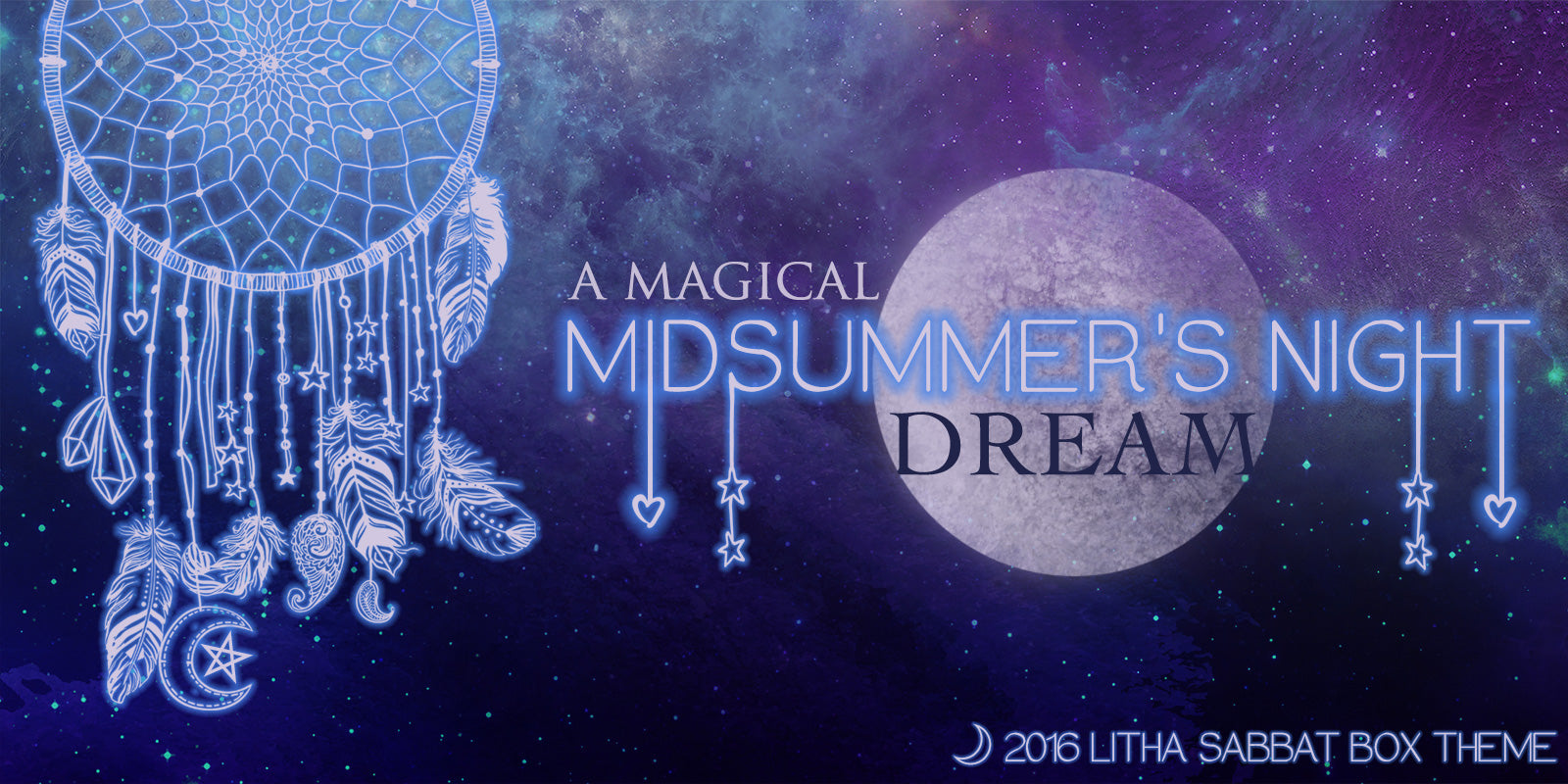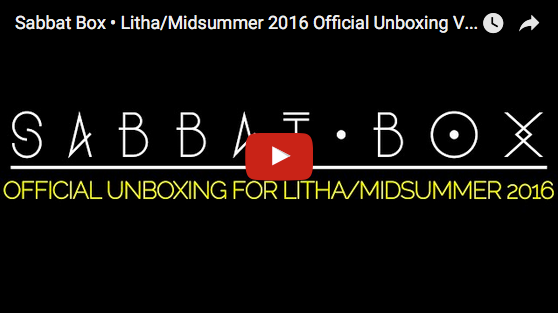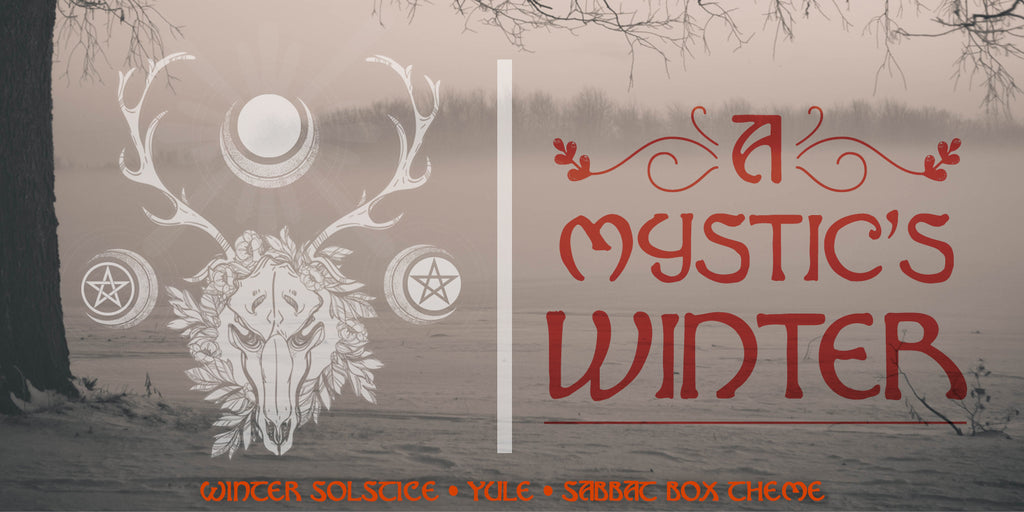Sabbat Box Blog — Sabbat Box Theme
Litha/Midsummer Sabbat Box Theme Release • A Magical Midsummer's Night Dream 1
The twenty-first day of June will see the longest day of the year here in the Northern Hemisphere, and the celebration of this time of fire and light will soon be upon us. Bonfires, feasts, and outdoor activities are the order of the day…a day that honors the sun reaching its apex, the God as solar deity in his full regalia, shining His life-giving force on plant and animal alike. Handfastings, along with “jumping the besom”—Pagan wedding ceremonies—are common, as the fiery celebration of life naturally leads to the celebration of joining two lives together.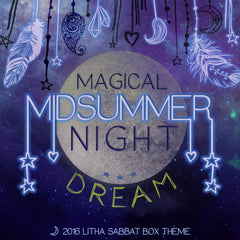 As the solstice sun sets, the night brings bonfires—called “setting the watch” by ancient European Pagans to spurn evil spirits away—as a means to extend the longest day even further to signify its importance in the dance between light and dark. And while the astronomical significance of this day centers on light and sunshine, Pagans and witches also turn their focus to the night on this bright day and its magickal significance. Our theme for this year’s Litha Sabbat Box is dedicated to the spell craft practiced after that longest day of the year comes to an end: A Magical Midsummer’s Night Dream.
As the solstice sun sets, the night brings bonfires—called “setting the watch” by ancient European Pagans to spurn evil spirits away—as a means to extend the longest day even further to signify its importance in the dance between light and dark. And while the astronomical significance of this day centers on light and sunshine, Pagans and witches also turn their focus to the night on this bright day and its magickal significance. Our theme for this year’s Litha Sabbat Box is dedicated to the spell craft practiced after that longest day of the year comes to an end: A Magical Midsummer’s Night Dream.
We are curating a special box focused on this shortest night and its sacred significance, which will contain a collection of items that will enhance your practice at this once-a-year time and focus on our nightly path. We hope that you can benefit from this collection of items that will be featured within the Litha Sabbat Box, as our goal is to connect to the protection and insight that Midsummer’s Night can bring, as well as use the opportunity to celebrate the sun while honoring the darkness.
When the longest day commences, we hope you celebrate the light and life that it brings, but we also encourage you to turn your attention to the power of magickal workings after the sun goes down. Workings and “mischief” glide as freely as fairy-wings in this shortest of nights, and it is our time to work our Ways and tread the briefly-darkened path until we sleep…and dream. The fairy Puck in Shakespeare’s A Midsummer’s Night Dream, states it thus:
brings, but we also encourage you to turn your attention to the power of magickal workings after the sun goes down. Workings and “mischief” glide as freely as fairy-wings in this shortest of nights, and it is our time to work our Ways and tread the briefly-darkened path until we sleep…and dream. The fairy Puck in Shakespeare’s A Midsummer’s Night Dream, states it thus:
“Now it is the time of night
That the graves all gaping wide,
Every one lets forth his sprite,
In the church-way paths to glide:
And we fairies, that do run
By the triple Hecate's team,
From the presence of the sun,
Following darkness like a dream,
Now are frolic: not a mouse
Shall disturb this hallow'd house:
I am sent with broom before,
To sweep the dust behind the door.”
— Puck, A Midsummer’s Night Dream, Act V, Scene I.
• SHOP ITEMS FROM OUR MIDSUMMER BOXES CLICK IMAGE BELOW •

• OFFICIAL 2016 LITHA UNBOXING VIDEO •
- Aeden B
- Tags: Litha Midsummer Midsummer Night's Dream Sabbat Box Theme Summer Solstice
Beltane Sabbat Box Theme Release • Earth's Instinct 0
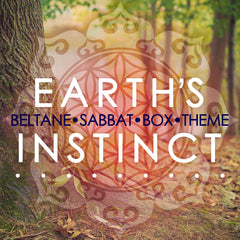 Though we live in the Northern Hemisphere and have started to celebrate the return of the sun since Imbolc, our Earth as a whole -- between the Northern and Southern hemispheres, lives in perpetual duality. What that means is, when looking at the Wheel of the Year, one is able to see that Beltane and Samhain occur at the half-way points, as we travel through the Wheel of the Year. With that being said, some believe that similarly with Samhain, "the veil," (the veil between the our world and the afterlife) is equally as thin on Beltane as it is on Samhain, making this is great time to include some ancestral workings or magick into your Beltane celebrations as well. Make an offering for your ancestors, family members that have passed or those who came before you. Though it may saddening, part of Earth's and nature's instinct is to bring about new life, and with that same natural force of life, comes death. Both serve a purpose to our existence and both are relative to the celebration of Beltane.
Though we live in the Northern Hemisphere and have started to celebrate the return of the sun since Imbolc, our Earth as a whole -- between the Northern and Southern hemispheres, lives in perpetual duality. What that means is, when looking at the Wheel of the Year, one is able to see that Beltane and Samhain occur at the half-way points, as we travel through the Wheel of the Year. With that being said, some believe that similarly with Samhain, "the veil," (the veil between the our world and the afterlife) is equally as thin on Beltane as it is on Samhain, making this is great time to include some ancestral workings or magick into your Beltane celebrations as well. Make an offering for your ancestors, family members that have passed or those who came before you. Though it may saddening, part of Earth's and nature's instinct is to bring about new life, and with that same natural force of life, comes death. Both serve a purpose to our existence and both are relative to the celebration of Beltane. • DISCOVER THE BELTANE SABBAT BOX FOR 2016 •
- Aeden B
- Tags: Beltane Earth's Instinct May Day Sabbat Box Theme Summer
Ostara Sabbat Box Theme Release • Emergence 0
• EMERGENCE •
Our theme this Sabbat for Ostara is emergence. As the Northern Hemisphere begins to green again, we can see this emergence over and over before our eyes: rising from the earth, hibernating animals make their way out of their dens; seedlings and bulbs poke out of the dirt and reach for the earlier sunrise; the Goddess has emerged from Her time of shadow and diminishment into a young Spring maiden. This is the time when many feasts and honorariums in ancient times were celebrated, praising and revering the vegetation gods and making sacrifices for a successful sowing of crops and increase in livestock. In a time when every new life, animal or vegetable, was crucial to continued survival, our Pagan ancestors looked to the joy of the baby calf or blooming flower as victory over the long darkness of winter.
 Ostara, historically, is also the Sabbat that commemorates the Spring Equinox. The word “East”—a cardinal direction most associated with the rising sun and the sign of air—comes from the German root word of Ostara. The day of the Spring Equinox brings alignment of the sun with due east, the day ending when the sun sets due west. This alignment is the first indication that there will be a time period when the days will now be longer than the night, allowing for increased sunshine and an abundance of light.
Ostara, historically, is also the Sabbat that commemorates the Spring Equinox. The word “East”—a cardinal direction most associated with the rising sun and the sign of air—comes from the German root word of Ostara. The day of the Spring Equinox brings alignment of the sun with due east, the day ending when the sun sets due west. This alignment is the first indication that there will be a time period when the days will now be longer than the night, allowing for increased sunshine and an abundance of light.Ostara also the foundation of another Christian holiday, built on ancient Pagan feasts and traditions: Easter. Like Yule, there are many overlaps in traditions and customs that ancient Pagans practiced that were soon adopted by Christians. The ancient fertility symbol of the egg, for instance, is representation of the new life (and potential for life) that appears in nests at this time of year. Another common Easter symbol is the hare—the “Easter Bunny”—which has long been a representation of new life and reproduction.
For Pagans, this Sabbat can also be described as “hopeful balance.” While it is an equinox, we understand that light and dark are swapping places, and that longer days and more light are our immediate future. This is a powerful time for Pagans to focus their works on increase, rising to the obstacles in life, and taking steps to foster financial and spiritual prosperity.

As you celebrate Ostara this year—however you choose to honor this rising emergence of Nature—we encourage you to face the rising sun and look forward to brighter days ahead. While we may not literally be resurrected or reborn at this time, the Sabbat gives us an opportunity to look at those areas of our lives that we can renew and refurbish.
Emerge from your dens, your caves of stagnation and lack! Throw off the winter coat of darkness and embrace the eastward dawn! Now is the time to allow yourself to be reborn—in your relationships, in your work, in your life. Rub your eyes and awaken! Let the spirit of Ostara help you shine a light on the path ahead. Emerge from the old and dead…awaken to the new!
• Want to join Sabbat Box? Sign up on the waiting list here.
OSTARA SABBAT BOXES ARE SET TO SHIP: MARCH 10, 2016

- Aeden B
- Tags: Emergence Ostara Sabbat Box Theme Spring Vernal Equinox
Imbolc Sabbat Box Theme Release • Nature's Renewal 0
• NATURE'S RENEWAL •
When winter starts to finally loose its grip, the first signs of spring are not far behind. By the first day of February (in the Northern Hemisphere), the days are lengthening and for many it means to prepare to plant and expect greenery to return... nature's renewal. It also represents a rough center point in time between the darkness of winter solstice and the soon-to-come spring equinox.
That special day—Imbolc—marks another turn on the Wheel of the Year. Its celebration, for many Pagans, is seen as the young Goddess soon ready to blossom into Her womanhood. Many covens and Pagan groups see this time as special for the feminine and all things Goddess. In fact, a number of Dianic Wiccans see Imbolc as the perfect time for initiations; again, turning to “coming of age” as a common theme at this time in the cycle of the seasons.
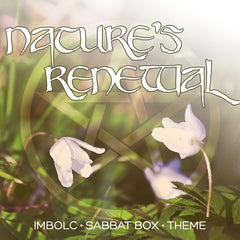 The history of Imbolc is long and dates back centuries, if not millennia. Ancient Gaelic Irish people saw the day as a time to celebrate Brigid, their goddess (only later becoming part of the Christian tradition, where she became Saint Brigid). They celebrated the day with a fertility festival where some of the last of the prior year’s harvest were laid out as a feast—a celebration that they had survived another turn of the earth, another period of darkness and lack and infertility, agriculturally speaking.
The history of Imbolc is long and dates back centuries, if not millennia. Ancient Gaelic Irish people saw the day as a time to celebrate Brigid, their goddess (only later becoming part of the Christian tradition, where she became Saint Brigid). They celebrated the day with a fertility festival where some of the last of the prior year’s harvest were laid out as a feast—a celebration that they had survived another turn of the earth, another period of darkness and lack and infertility, agriculturally speaking.
Some other prominent practices for this date was to celebrate home and hearth, particularly by lighting fires and candles, as if to encourage the lengthening sunny days. Of course, not only was fire seen as an important light source, but also could serve as a purification or cleansing force. In fact, this most likely is where the old concept of “spring cleaning” occurred: a chance to clear out the old and welcome the new.
And as much as fire plays a role in Imbolc, water—and its own cleansing powers—also has a large part in practices both ancient and current. As the chalice is the visual representation of the feminine, the water it can hold symbolizes similar importance. Historically for the Gaels and the Irish, this was also a time to make pilgrimages to sacred wells: pools and natural springs the Goddess inhabits. Many seekers would pray for health while walking “sunwise” (clockwise, or deosil) around the sacred “chalice of the earth.”
Weather divination is another practice long associated with Brigid and her festival. Obviously this time of year represented a look forward to the coming growing season; thoughts and intuitions about the future were only natural. Using various signs from the local surroundings by Pagans to predict the near future such as seeing if serpents or badgers would come out of their dens at this time to forecast how soon winter would officially be over. Even non-Pagans today will mark this time in such a way, although its modern manifestation is a groundhog (on February 2nd) instead of a badger or snake.
Brigid is seen by some as the original Goddess. It was believed that she would make the rounds on Imbolc Eve and bless virtuous households with prosperity and fertility in the coming seasons. A common practice at the time in Ireland, for instance, was to invite Brigid into the house and make a bed for her. One of the family members—generally a young woman who has reached childbearing years (or soon will)—would circle the house three times, each time knocking on the door to be let in. On the third attempt, she would be welcomed in, and then there would be a feast meal. After the meal, Brigid’s bed would be made by placing rushes, or reeds, on the floor. In some traditions, it is reported that a white wand made of birch would be placed near the bed, which was an invitation for Brigid to use it in bringing back the spring. Another common practice was to create a Brigid’s Cross, created from more reeds and hung above doorways or windows in the home to protect it from fire or illness.
Many other practices for Imbolc and Brigid’s Day are documented historically, including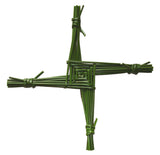 its eventual inclusion into Christian practice as well as another commonly celebrated holiday/sabbat known as Candlemas. How do you personally celebrate Imbolc? What traditions or importance do you keep at this hopeful time of year? Whatever your path or observation of Imbolc, all can agree that this time marks when the cold and dark will soon be replaced by the renewal of light and warmth…and in turn, a hope of good life and happiness.
its eventual inclusion into Christian practice as well as another commonly celebrated holiday/sabbat known as Candlemas. How do you personally celebrate Imbolc? What traditions or importance do you keep at this hopeful time of year? Whatever your path or observation of Imbolc, all can agree that this time marks when the cold and dark will soon be replaced by the renewal of light and warmth…and in turn, a hope of good life and happiness.
We plan on including some wonderfully magical items inside the Imbolc Sabbat Box to help make aid your sabbat celebrations and welcome nature's renewal.
- Llyfr Glas
- Tags: Candlemas Imbolc Nature's Renewal Sabbat Box Theme
Yule Sabbat Box Theme Release • A Mystic's Winter 3
• A MYSTIC'S WINTER •
As the mundane calendar year starts to count down, the Pagan year—beginning at Samhain—is just getting under way. The Winter Solstice, also known as Yule, is the first important milestone of this new Pagan year calendar, and in harsher times, often the most worrisome. The Pagans of old faced the shortest day of the year--the winter solstice--worried if the previous season's crops would last until spring, but came together to remind each other that even the very next day would be longer and the promise of spring was not far off. How? By celebrating the re-birth of the God, the baby who would grow and mature like the bulbs of flowers that would soon emerge from the frozen ground, with feasts and songs and light. Light that shone against the longest night.
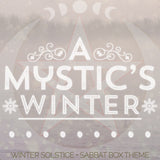 So what is a mystic's winter? A mystic's winter is about finding and embracing the magic and beauty of winter season. A mystic may find beauty in the white of the freshly fallen snow, and drawing in the powers that be, on a cold winter's day. A mystic may find beauty within the longer, darker nights, by embracing the shadows cast by the dark of the night and light of the moon. A mystic will embrace the winter and use it to his or her advantage, calling upon all that still manifests during the season to bring about their desires. As mother nature humbles herself before us all, with her trees leafless and naked, the mystic will use this time to contemplate, reflect and heal during this time of transition, much similar to that of the land in which the mystic draws their power from.
So what is a mystic's winter? A mystic's winter is about finding and embracing the magic and beauty of winter season. A mystic may find beauty in the white of the freshly fallen snow, and drawing in the powers that be, on a cold winter's day. A mystic may find beauty within the longer, darker nights, by embracing the shadows cast by the dark of the night and light of the moon. A mystic will embrace the winter and use it to his or her advantage, calling upon all that still manifests during the season to bring about their desires. As mother nature humbles herself before us all, with her trees leafless and naked, the mystic will use this time to contemplate, reflect and heal during this time of transition, much similar to that of the land in which the mystic draws their power from. Our goal with the Yule Sabbat Box is to provide you items that will allow you to capture the magick of the winter season, as well as add a few unique items into your magickal practice that you may not have thought to use before. The items that will be featured inside are also there to help you draw in inspiration from the season and hopefully inspire your inner mystic to work with the season of darkness and change.
- Aeden B
- Tags: Sabbat Box Theme Winter Solstice Yule
Samhain Sabbat Box Theme Release • The Witches' Sabbath 0
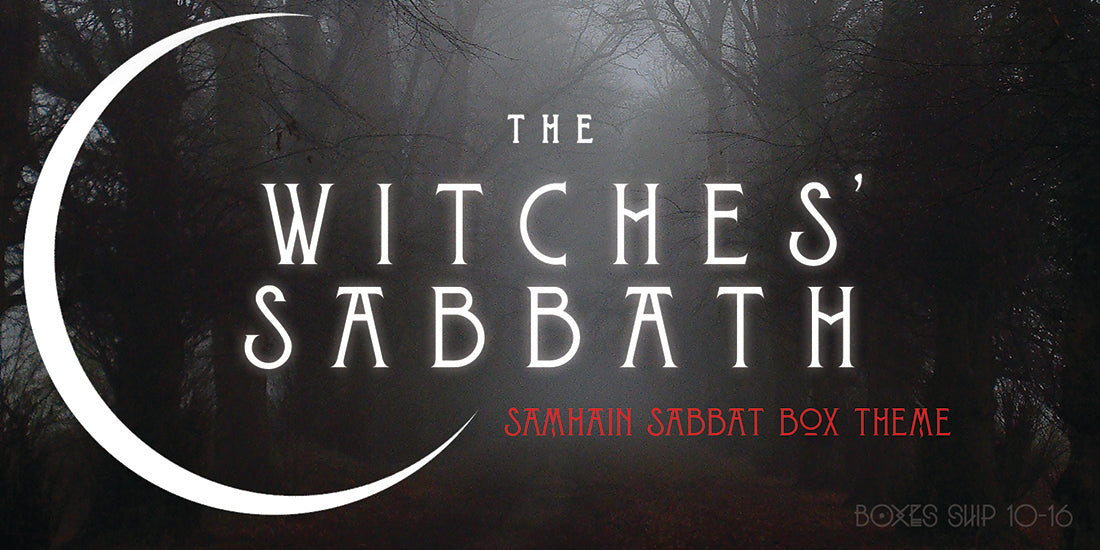
• THE WITCHES' SABBATH •
As the last herbs dry above the fire and the late autumn vegetables sweeten in the earth before they are laid by the root cellar, we take stock. Not just what is needed for winter, but what has come before us and what may lie ahead. Now is the time to peer into the darkening world and face our fears, our anxieties, not forgetting what we have done and what we have yet to do.
 The veil between the seen and the unseen is thinnest now, and it calls for a look inward to remember and honor those who are gone from the here and now, who provided for us and protected us. We hearken their lessons and recall the stories they shared for survival in the dark. To remember them, some may observe Samhain by hosting a “dumb supper”—a meal, or place at their table for those who have passed on. So feed the dead. Not for their sake, but for your own. Feed their memory to your soul, your consciousness. They did not live or die in vain; they gave you much, and a night of remembrance and commemoration of those who are now gone is powerful magic.
The veil between the seen and the unseen is thinnest now, and it calls for a look inward to remember and honor those who are gone from the here and now, who provided for us and protected us. We hearken their lessons and recall the stories they shared for survival in the dark. To remember them, some may observe Samhain by hosting a “dumb supper”—a meal, or place at their table for those who have passed on. So feed the dead. Not for their sake, but for your own. Feed their memory to your soul, your consciousness. They did not live or die in vain; they gave you much, and a night of remembrance and commemoration of those who are now gone is powerful magic.Our goal with the Samhain Sabbat Box is to hopefully stimulate ideas and provide tools for you as you celebrate the Sabbath of the Witch, so spend some time taking stock. What do you have to work with? What did those who came before you leave you, in body and in spirit? What do you need for the trying times that may lay ahead? What hope can you see in the dark?
At Samhain the wheel of the year turns again and comes to an end of sorts (in fact, in some traditions, Samhain is considered the witches' new year). But every end is a beginning, and we, even in encroaching darkness, left with our thoughts and the gifts from our ancestors, should embrace hope. The fervent hope that light will return, the scales will again tip toward life, and we will flourish once again.
- Llyfr Glas
- Tags: Sabbat Box Theme Samhain The Witches' Sabbath

